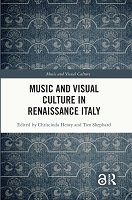Chapter 15 Fantastic Finials
Proposal review
The Materiality, Decoration and Display of Renaissance Musical Instruments
| dc.contributor.author | Vai, Emanuela | |
| dc.date.accessioned | 2023-10-04T11:33:32Z | |
| dc.date.available | 2023-10-04T11:33:32Z | |
| dc.date.issued | 2023 | |
| dc.identifier.uri | https://library.oapen.org/handle/20.500.12657/76543 | |
| dc.description.abstract | Renaissance musical instruments frequently feature masterfully carved figures, intricate geometric and arabesque patterns, expensive and exotic materials, and a variety of pictorial representations. The headstocks and pegboxes of stringed instruments, in particular, often feature carved finials with anthropomorphic, zoomorphic, and monstrous figures. Taking as its entry-point the pegboxes of three citterns from the Ashmolean Museum's collection of stringed instruments, this chapter explores what these visual and material features say about the role that musical objects played in Renaissance social worlds, beyond their music-making capacities. While there has long been critical interest in the material culture of music in Renaissance studies, object-orientated approaches and new materialist frameworks invite us to reflect more deeply on the social, political, and affective dimensions of the materiality of musical instruments. Renaissance musical instruments were often designed for the eye as much as the ear, to be seen—and otherwise sensed—as well as played. A focus on their ornamental features opens valuable windows onto questions of power in Renaissance music cultures. Such a focus directs attention to the material environments and social settings in which these instruments were played and dis-played. These elaborately decorated musical objects articulated values concerning gender, wealth, knowledge, and prestige. Their ornamentation also invites reflection on the circulation of aesthetic influences beyond Europe, on the colonial and racial relations of Renaissance music within an interconnected global culture. | en_US |
| dc.language | English | en_US |
| dc.subject.other | Italian musical culture, Italy, Music, Musical pictures, Renaissance, Renaissance art theory, Visual media, fifteenth century music, musical media, paragone | en_US |
| dc.title | Chapter 15 Fantastic Finials | en_US |
| dc.title.alternative | The Materiality, Decoration and Display of Renaissance Musical Instruments | en_US |
| dc.type | chapter | |
| oapen.identifier.doi | 10.4324/9781003029380-18 | en_US |
| oapen.relation.isPublishedBy | 7b3c7b10-5b1e-40b3-860e-c6dd5197f0bb | en_US |
| oapen.relation.isPartOfBook | 446ff4f7-00a9-4722-9f31-8644eb95cc52 | en_US |
| oapen.relation.isFundedBy | f1196b48-25e5-4b94-9fc8-06aec3066142 | en_US |
| oapen.relation.isbn | 9780367465391 | en_US |
| oapen.relation.isbn | 9781032036083 | en_US |
| oapen.imprint | Routledge | en_US |
| oapen.pages | 29 | en_US |
| oapen.remark.public | Funder name: Opler Fellowship, Worcester College | |
| peerreview.anonymity | Single-anonymised | |
| peerreview.id | bc80075c-96cc-4740-a9f3-a234bc2598f1 | |
| peerreview.open.review | No | |
| peerreview.publish.responsibility | Publisher | |
| peerreview.review.stage | Pre-publication | |
| peerreview.review.type | Proposal | |
| peerreview.reviewer.type | Internal editor | |
| peerreview.reviewer.type | External peer reviewer | |
| peerreview.title | Proposal review | |
| oapen.review.comments | Taylor & Francis open access titles are reviewed as a minimum at proposal stage by at least two external peer reviewers and an internal editor (additional reviews may be sought and additional content reviewed as required). |

